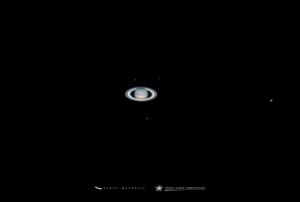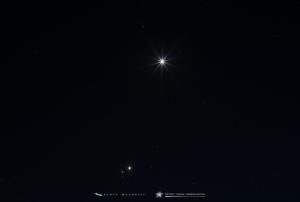
Stargazing Nights
- Where:
- Frosty Drew Observatory
- When:
- Friday March 1, 2019 at 7:00 p.m
- Cost:
- $5 Suggested Donation per person 5 years and older
Tonight is Stargazing Night at Frosty Drew Observatory and forecasts are not looking very promising. We can expect heavy haze-like conditions this evening, with clouds increasing in the early nighttime hours. Eventually, snow and sleet will move into the region overnight. Considering we have no Moon present until the 14% waning crescent rises at 4:20 am, the Moon will not save us from thin cloud cover. Though we could score a couple views of brighter objects during the first hour or two of our geek out. It may not be a fabulous night, but we’ll work with what we have.
The Observatory and Sky Theatre will open at 7:00 pm tonight. In the Observatory, telescopes will start off on standby as we evaluate sky conditions. If the skies are clear enough we will direct the big telescope towards any visible objects. The late-winter starscape offers up a nice selection of binary stars, nebulae, star clusters, and galaxies. Since we have no Moon, the skies have the potential to be amazing. If on the clearer side, we’ll rock the Orion Nebula, R-Lepus – a carbon star, the Messier 46 open star cluster, and more. If skies are what we expect, cloudier, we will focus on binary stars Rigel, Sigma Orion, Beta Monoceros, Algieba, Cor Caroli, and more. Though if skies are too cloudy for telescope viewing, we will move into the Sky Theatre, where we will feature images of the total lunar eclipse that were captured at Frosty Drew Observatory on January 20-21, 2019. Our astronomers will host a commentary of the eclipse, as well as an open discussion on general astronomy. We’ll stay open until 11:00 pm or until clouds chase us out, no earlier than 9:00 pm. Checking in on our Twitter (@FrostyDrewOBSY) or the right column of our website will get you updates from the Observatory on what we are seeing, including a closing up post when we decide to pack up.
Overall, tonight is probably a night to sit out. Increasing clouds and the onset of snow will make for unfavorable viewing conditions, and questionably risky travel conditions. Cloud cover will start off as high cirrus clouds, which we can observe through if thin enough, though heavier cloud cover will move in by 10:00 pm. If you’re in the local area and are looking to catch up on your astro-geek, then stop in for a quick fix and catch up with our astronomers. Otherwise, grab a blanket, fluffy kitty, and a cozy spot to enjoy the snow.
-----------------------------
Weekly Happenings
Scott MacNeill
Over the past couple of months, we have been received quite a few inquiries about “the bright objects” in the early morning sky before sunrise. Though our minds often start off with the most abstract thought, given the chance we can quickly return our thinking to a less fantastical reality. What we have been seeing in the morning are the return of the naked-eye-visible planets that have been out of view during this winter’s evening and nighttime skies. There are three naked eye planets visible in the morning sky at this time, including Venus, Saturn, and Jupiter (ordered from E→W).
The brightest of the group is, without a doubt, Venus, which shines brighter than everything else in the sky aside from the Sun and the Moon. Venus achieved maximum western elongation on January 6, 2019, which is when Venus is at its greatest visible distance from the Sun when orientated on the western side of the sky in relation to the Sun. Since then, Venus has been slowly moving closer to the Sun from our point of view (in reality, Venus is orbiting further away from us as it moves into a position on the opposite side of the Sun than Earth). Over the next two weeks we will begin to lose Venus to the rising Sun.
The next brightest object we are seeing in the morning sky is Jupiter, which is a fabulous target for telescope observation! Jupiter, being an outer planet in relation to Earth’s position in the Solar System, does not continually hang around the Sun like Venus and Mercury do from our vantage point. So Jupiter has been rising earlier with each passing day, appearing above the horizon for longer periods of night, consecutively. This is due to Earth orbiting into a position in between Jupiter and the Sun. The opposition of Jupiter will happen on June 10, 2019, which occurs when Earth arrives at the point in our orbit around the Sun, where Jupiter is on the opposite side of Earth than the Sun. Around April 20, 2019, Jupiter will start rising into the nighttime sky, with May being the month that we start regularly observing Jupiter in the Frosty Drew Observatory primary telescope on Friday nights.
The least brightest of the current morning naked eye planets is Saturn, our favorite planet to observe at Frosty Drew Observatory. Like Jupiter, Saturn is an outer planet in relation to Earth’s position in the Solar System, and will rise earlier with each passing night as Earth orbits in between the Sun and Saturn, eventually rising into the nighttime and evening sky. On July 9, 2019, Earth will arrive at the point in our orbit where Saturn is on the opposite side of Earth than the Sun, this is the opposition of Saturn. Though starting around May 17, 2019, Saturn will begin to rise into the nighttime sky, becoming a fabulous target for the Frosty Drew Observatory telescopes shortly after.
Though 2020 will be the year for observing the naked eye planets! Consider this, each planet resides at a different distance from the Sun and as a result have different orbital periods around the Sun (the time it takes to complete one full orbit around the Sun). For example, Jupiter resides at near 484 million miles distant from the Sun and has an orbital period of 11.86 Earth years. Saturn resides at near 891 million miles distant from the Sun and has an orbital period of 29.45 Earth years. Because of these differences in orbital periods and because the planets all orbit the Sun on nearly the same plane (the ecliptic), the planets will appear to pass very close to each other, periodically, when viewed from Earth. This will happen in 2020, during which Saturn and Jupiter will approach each other in our night sky over the course of the year. Starting in early March 2020, one year from now, Mars will begin to enter the conjunction. Mars which resides at, on average, 142 million miles distant from the Sun, and has an orbital period of near 687 Earth days, which is about 43 days shy of twice the orbital period of Earth (365 days), and places Mars at opposition once every two years. The best dates to view the conjunction of Saturn, Jupiter, and Mars will be in the morning hours on March, 4, 2020, when the three are all within a 15° area of the sky. Then again on March 20, 2020 (there are a lot of 20’s in that date! But certainly not magical), when Mars and Jupiter are about 0.3° apart, with Saturn sitting about 6.4° to the east. Followed by March 31, 2020 when Mars arrives within 0.7° of Saturn, with Jupiter sitting about 6° to the west. Though the best view of the Saturn / Jupiter conjunction will happen on December 21, 2020, the Winter Solstice, in the evening sky just after sunset. On this night Jupiter will pass below Saturn within a visible distance of 5 arc minutes, that’s 0.083° apart! Close enough that Jupiter’s moons and Saturn’s moons will appear to nearly overlap when viewed in a telescope.
The dates listed above are notable viewing dates of the conjunction next year, though the conjunction itself will be happening throughout Jupiter and Saturn’s entire 2020 viewing season. There will be numerous opportunities to catch the Moon joining in the conjunction as well. So when stepping outside and catching sight of the bright naked eye planets in the morning sky, keep in mind that stunningly beautiful views of the naked eye planets are on the list for 2020, with a conjunction of Jupiter and Saturn which will not happen again for another 40 years, and on that date, Venus, and the Moon will join in the dance of the planets.
-Scott




